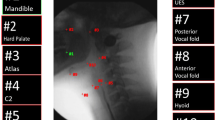Abstract
Swallowing impairment (dysphagia) is a common sequela in patients with motor neuron disease (MND). The purpose of this retrospective, observational pilot investigation was to characterize how pharyngeal swallowing mechanics are impacted in patients with MND using a comparison with healthy, non-dysphagic control group. Computational analysis of swallowing mechanics (CASM) was used to determine covariate biomechanics of pharyngeal swallowing from videofluoroscopic assessment in 15 patients with MND and 15 age- and sex-matched healthy controls. Canonical variant analysis with post hoc discriminate function analysis (DFA) was performed on coordinate data mapping functional muscle groups underlying pharyngeal swallowing. Differences in swallowing mechanics associated with group (MND; control), motor neuron predominance (upper; lower), onset (bulbar; spinal), and swallow task (thin, pudding) were evaluated and visualized. Pharyngeal swallowing mechanics differed significantly in patients with MND compared with healthy controls (D = 2.01, p < 0.0001). Post hoc DFA pairwise comparisons suggest differences in pharyngeal swallow mechanics by motor neuron predominance (D = 5.03, p < 0.0001), onset (D = 2.03, p < 0.0001), and swallow task (D = 1.04, p < 0.0001). Pharyngeal swallowing mechanics of patients with MND differ from and are more heterogeneous than healthy controls. These findings suggest patients with MND may compensate reductions in pharyngeal shortening and tongue base retraction by extending the head and neck and increasing hyolaryngeal excursion. This work and further CASM investigations will lead to further insights into development and evaluation of targeted clinical treatments designed to prolong safe and efficient swallowing function in patients with MND.




Similar content being viewed by others
References
Paris G, Martinaud O, Petit A, Cuvelier A, Hannequin D, Roppeneck P, et al. Oropharyngeal dysphagia in amyotrophic lateral sclerosis alters quality of life. J Oral Rehabil. 2013;40:199–204. doi:10.1111/joor.12019.
Tabor L, Gaziano J, Watts S, Robison R, Plowman EK. Defining swallowing-related quality of life profiles in individuals with amyotrophic lateral sclerosis. Dysphagia. 2016;31:376–82. doi:10.1007/s00455-015-9686-2.
Robbins J. Swallowing in ALS and motor neuron disorders. Neurol Clin. 1987;5:213–29.
Hillel AD, Miller R. Bulbar amyotrophic lateral sclerosis: patterns of progression and clinical management. Head Neck. 1989;11:51–9.
Hadjikoutis S, Wiles CM. Respiratory complications related to bulbar dysfunction in motor neuron disease. Acta Neurol Scand. 2001;103:207–13.
Corcia P, Pradat P-F, Salachas F, Bruneteau G, le Forestier N, Seilhean D, et al. Causes of death in a post-mortem series of ALS patients. Amyotroph Lateral Scler. 2008;9:59–62.
Kawai S, Tsukuda M, Mochimatsu I, et al. A study of the early stage of dysphagia in amytrophic lateral sclerosis. Dysphagia. 2003;18(1):8. doi:10.1007/s00455-002-0074-3.
Palovcak M, Mancinelli JM, Elman LB, McCluskey L. Diagnostic and therapeutic methods in the management of dysphagia in the MND population: issues in efficacy for the out-patient setting. NeuroRehabilitation. 2007;22:417–23.
Ruoppolo G, Schettino I, Frasca V, et al. Dysphagia in amyotrophic lateral sclerosis: prevalence and clinical findings. Acta Neurol Scand. 2013;128:397–401. doi:10.1111/ane.12136.
Higo R, Tayama N, Nito T. Longitudinal analysis of progression of dysphagia in amyotrophic lateral sclerosis. Auris Nasus Larynx. 2004;31:247–54.
Higo R, Tayama N, Watanabe T, Nitou T. Videomanofluorometric study in amyotrophic lateral sclerosis. Laryngoscope. 2005;5:911–7. doi:10.1016/j.anl.2004.05.009.
Thompson ZT, Obeidin F, Davidoff AA, Hightower CL, Johnson CZ, Rice SL, et al. Coordinate mapping of hyolaryngeal mechanics in swallowing. J Vis Exp. 2014;87. https://www.ncbi.nlm.nih.gov/pmc/articles/PMC4132872/. Accessed 22 June 2017.
Pearson WG, Taylor BK, Blair J, et al. Computational analysis of swallowing mechanics underlying impaired epiglottic inversion. Laryngoscope. 2016;126:1854–8. doi:10.1002/lary.25788.
Pearson WG, Zumwalt AC. Visualising hyolaryngeal mechanics in swallowing using dynamic MRI. Comput Methods Biomech Biomed Eng Imaging Vis. 2014;2:208–16. doi:10.1080/21681163.2013.846231.
Webster M, Sheets HD, Alroy J, et al. A practical introduction to landmark-based geometric morphometrics. Qant Meth Paleobiol Palentol Soc Papers. 2010;16:163–88.
May NH, Pisegna JM, Marchina S, Langmore SE, Kumar S, Pearson WG. Pharyngeal swallowing mechanics secondary to hemispheric stroke. J Stroke Cardiovasc Dis. 2017;26:952–61. doi:10.1016/j.jstrokecerebrovasdis.2016.11.001.
Martin-Harris B, Brodsky MB, Michel Y, Castell DO, Schleicher M, Sandidge J, et al. MBS measurement tool for swallow impairment-MBSImp: establishing a standard. Dysphagia. 2008;23:392–405. doi:10.1007/s00455-008-9185-9.
Natarajan R, Stavness I, Pearson W Jr. Semi-automatic tracking of hyolaryngeal coordinates in videofluoroscopic swallowing studies. Comput Methods Biomech Biomed Eng Imaging Vis. 2015;2015:1–11.
Klingenberg CP. MorphoJ: an integrated software package for geometric morphometrics. Mol Ecol Resour. 2011;11:353–7. doi:10.1111/j.1755-0998.2010.02924.x.
Webster M, Sheets DH. A practical introduction to landmark-based geometric morphometrics. In: Alroy J, Hunt G, editors. Quantitative methods in paleobiology. Boulder: Paleontological Society; 2010. p. 163–88.
Tran TTA, Martin-Harris B, Pearson WG. Improvements resulting from respiratory-swallow phase training visualized in patient-specific computational analysis of swallowing mechanics. Comput Methods Biomech Biomed Eng Imaging Vis. 2016;2016:1–7.
Strand EA, Miller RM, Yorkston KM, Hillel AD. Management of oral-pharyngeal dysphagia symptoms in amyotrophic lateral sclerosis. Dysphagia. 1996;11:129–39.
Crary MA, Mann GD, Groher ME. Initial psychometric assessment of functional oral intake scale for dysphagia in stroke patients. Arch Phys Med Rehabil. 2005;86:1516–20.
Funding
This study was partially supported by the following grant mechanisms: Veterans Affairs, RR&D 1IK1RX001628-01A1 (PI: Garand); National Institutes of Health, NCATS TL1R000061 (PI: Brady: Project PI: (Focht) Garand; National Institutes of Health, NIDCD 1K24DC12801 (PI: Martin-Harris); and American Speech-Language-Hearing Foundation (Recipient: Garand). Further, this study was partially supported by the J. Harold Harrison M.D. Scholars Program and MCG Medical Scholars Program at Augusta University.
Author information
Authors and Affiliations
Corresponding author
Ethics declarations
Conflicts of interest
The authors declare that they have no conflict of interest.
Rights and permissions
About this article
Cite this article
Garand, K.L., Schwertner, R., Chen, A. et al. Computational Analysis of Pharyngeal Swallowing Mechanics in Patients with Motor Neuron Disease: A Pilot Investigation. Dysphagia 33, 243–250 (2018). https://doi.org/10.1007/s00455-017-9853-8
Received:
Accepted:
Published:
Issue Date:
DOI: https://doi.org/10.1007/s00455-017-9853-8




